Wilsons Promontary Camp

Sunday 15 - Saturday 21 April 2012
Led by Kay
Words by Helen, Joan, Ann & Len : Photos by Len, Kay, Donna, Helen
INDEX
Day 1, Monday
Day 2, Tuesday
Day 3, Wednesday
Day 4, Thursday
Day 5, Friday
Wakeful in Wilsons Prom, Helen & Martin's Wombat Tale
Day 1 Monday, Medium/Hard Walk, Darby Saddle, Tongue Point, Darby River, Darby Beach
With the promise of a mainly downhill walk from the camp and only the smallest
chance of rain, 13 walkers set off on the 9.4 km walk from Darby Saddle to
Tongue Point, past Fairy Cove and ending up at Darby River. To make us feel
more virtuous and to bolster our belief that this was a medium/hard walk, we
also walked the 2.2 km to and from Darby Beach.
After the compulsory group photo at the sign post, we set off
UPHILL! Fabulous views in clear sunshine encouraged us on, some red heath
flowers were out and watching some birds helped us up the hills, but it was the
granite rock formations and the turquoise sea that stole the show, they were
stunning. Photos of various bushwalkers on various rocks at various lookouts
are the proof.
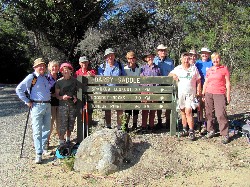 |
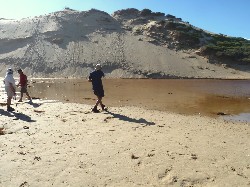 |
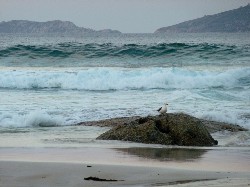 |
Group photo
Click on thumbnail to enlarge photo |
Mike and Martin stone skimming
Click on thumbnail to enlarge photo |
Darby Beach
Click on thumbnail to enlarge photo |
Coming round a hill to the river valley revealed another aspect of Wilsons
Prom, a deep dark river snaking in marshland and the recently mended Darby
Bridge that was washed away in the April 2011 floods. Then the walk to the
beach, the sand cliffs were impressive, a group of Pacific Gulls watched us,
and Mike and Martin had a stone-skimming competition. The sea, though beautiful
tempted no-one! An excellent introduction to Wilsons Prom....Helen
Day 1 Monday, Easy/Medium Walk, Darby Saddle to Tongue Point
The day started out to be very sunny and warm as 14 bushwalkers headed off
to Darby River car park to commence our walk. We hadn’t gone very far when we
came across a young wombat that had obviously had an altercation with a fellow
beastie and come off second best, as he had numerous scars across his back and
was trying to keep his strength up by non-stop eating of the vegetation, even
when being patted and scratched, and having his photo taken.
We started up the hillside which turned out to be quite a steep boardwalk in
the beginning, but gradually eased up to be an easier traverse up the side and
then levelled out, but we did have to watch out as the path was quite gravelly
and slippery in places. The views were magnificient with some rocks looking
like prehistoric animals lying in wait for the unwary traveller. We passed a
very pretty bay called Fairy Cove and then went on towards Tongue Point where
we stopped for lunch. We returned the same way making good time arriving back
at the cars about 1 o’clock. Thanks John for a wonderful walk.....Ann
back to Top
Day 2 Tuesday, Len's Solo Lighthouse Walk
I set off early on Tuesday morning to walk the 24 km to the Lighthouse. I
was pleased that the northern section of the Telegraph Track was closed to
visitors because the alternative route via Oberon Bay was much more scenic and
more interesting despite the extra 4 km distance. Helen and Martin accompanied
me as far as the campsite at Oberon Bay, and I really appreciated their company.
The walk from there to Halfway Hut was fairly easy going, but the climb from
there up to the top of Telegraph Saddle took some energy. After that the walk
was relatively easy down to the Roaring Meg campsite. This is a lovely campsite
for overnight campers with a really nice stream running past and some good flat
clear spaces for pitching tents. From there on I had the choice of the walking
track, which has not yet been restored after the devastating floods of March
2011, or the Telegraph Track. I chose the walking track which was much more
scenic although somewhat hilly and also badly eroded in places. The last
section was a good walking track down to close to the lighthouse, followed by a
very steep 700 metre concrete driveway up to the lighthouse itself, which was a
real effort after a 23 km walk with full pack.
The accommodation was in one of the five the lighthouse keepers cottages
which were the old solid brick houses with high internal ceilings, beautifully
restored and beautifully maintained, but with modern bathrooms and kitchen.
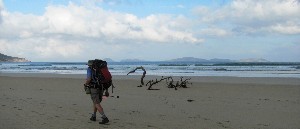 |
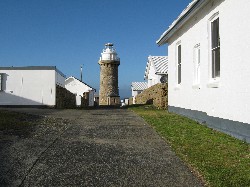 |
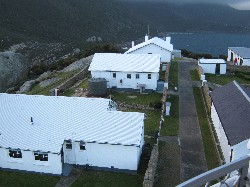 |
Len strides out to the Lighthouse solo
Click on thumbnail to enlarge photo |
Wilsons Prom Lighthouse
Click on thumbnail to enlarge photo |
Lighthouse cottages from top of lighthouse
Click on thumbnail to enlarge photo |
On the Wednesday I walked about halfway to Little Waterloo Bay on a good
walking track with some nice ocean views and a section of good rainforest.
That afternoon the caretaker at the Lighthouse took me and the one other guest
on a tour of the lighthouse, which was most interesting, and included much of
the history.
The lighthouse was completed in 1859 and was originally fitted
with a series of oil lamps burning whale oil or any other fuel that was available.
It was later converted to pressurised kerosene lamps (similar to Tilley lamps)
and the whole arrangement floated in a bath of mercury, which allowed it to
rotate on a virtually frictionless bearing. The rotation was driven by a
clockwork mechanism driven by falling lead weights which the lighthouse keepers
had to wind back up every three hours. This was later converted to a series of
200 watt sealed beam lights similar to car headlights and powered by a diesel
generator.
The lighthouse has since been converted to using a single 30 watt bulb with
lenses which enable the beam to be seen 18 nautical miles to sea, supplied with
solar power, and with fully automatic operation. It can even change light
bulbs automatically if one fails. Power supply for the cottages is provided by
a four-cylinder diesel generator which charges up a large battery bank and an
inverter then converts the DC supply to 240 volt AC.
Supplies to the lighthouse were originally brought in by ship, and a wharf
and crane were provided on the eastern side of the peninsula. All equipment,
supplies etc. were then raised up to the top site by means of a flying fox
powered by a steam driven winch. Nowadays, all supplies are delivered by
helicopter and a 4 wheel drive vehicle is used to transport supplies up to the top.
My walk back on Wednesday was generally uneventful, and I chose the
Telegraph Track route back to Roaring Meg in preference to the walking track.
Although 1.7 km longer it was mostly flat, and I covered the distance in about
the same time as on Tuesday, but with less effort. This is a walk that I can
recommend to anyone who is prepared to put in the effort to get there....Len
Day 2 Tuesday, Tidal River to Oberon Bay
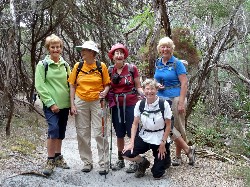 |
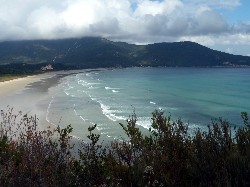 |
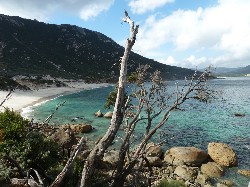 |
Lorelle, Irene, Lesley, Susan, Donna
Click on thumbnail to enlarge photo |
Norman Bay
Click on thumbnail to enlarge photo |
Little Oberon Bay
Click on thumbnail to enlarge photo |
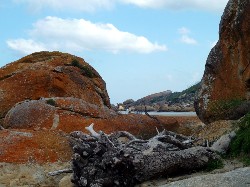 |
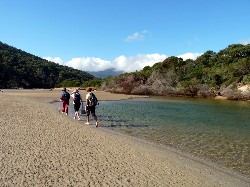 |
Lichen covered boulders
Click on thumbnail to enlarge photo |
Soothing those tired feet
Click on thumbnail to enlarge photo |
The track from Tidal River led uphill until we reached the southern end of
Norman Bay. From here we followed the walking track around the headland, taking
a short but steep climb down to Norman Point with great views of Norman and
other outlying islands - a fabulous spot for morning tea
Continuing on round the headland we reached little Oberon Beach where the
mountain side was scarred by a huge landslip, a casualty of the heavy deluge
of rain in 2011. The mountainside was covered in huge boulders of varying
shapes and sizes, some balanced precariously. Some of the walkers stayed here
for lunch before making the return trip.
Eventually the remaining walkers reached Oberon Bay where all but four
stopped for lunch. The four stalwarts walked south along the beach to the
campsite where a table made of various lengths of driftwood provided a
suitable spot for lunch.
On the return journey some groups walked back along Norman Beach, happy to
soothe their tired feet in the sea. The whole walk offered spectacular
panoramic views of pristine beaches, rocky outcrops and aqua seas.....Nice
report, whoever you are
back to Top
Day 3 Wednesday, Lay Day
In the absence of nearby shops, cafes or other trappings of civilisation, many
spent the Lay Day walking various sections of the Coastal Track from Tidal River
Campsite to Whisky Bay.
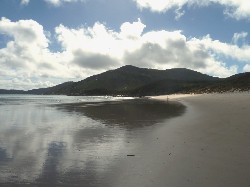 |
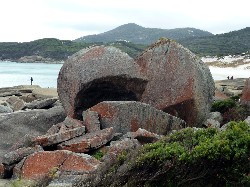 |
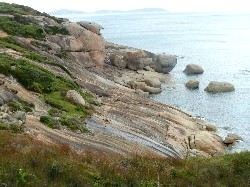 |
En route to Whisky Bay
Click on thumbnail to enlarge photo |
Rocky outcrops
Click on thumbnail to enlarge photo |
Coastal views
Click on thumbnail to enlarge photo |
back to Top
Day 4 Thursday, Medium/Hard Walk, Vereker Lookout and Lower Barry Track
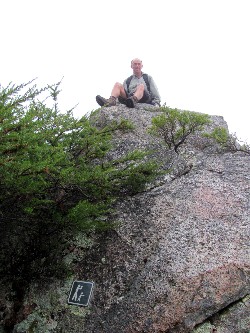 |
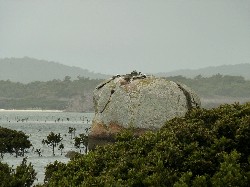 |
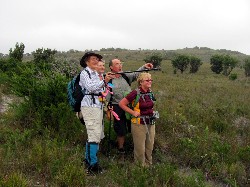 |
Martin scans the whiteout from Vereker Lookout
Click on thumbnail to enlarge photo |
Mangroves in the mist
Click on thumbnail to enlarge photo |
There's a view here somewhere
Lower Barry Creek Track
Click on thumbnail to enlarge photo |
Day 4 Thursday, Medium Walk, Vereker Lookout and Millers Landing
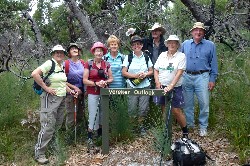 |
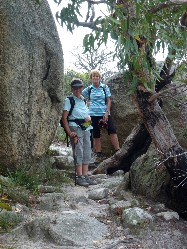 |
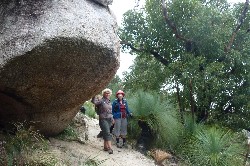 |
Group photo
Click on thumbnail to enlarge photo |
Jill and Lorelle at Vereker Lookout
Click on thumbnail to enlarge photo |
Donna and Lesley at the Lookout
Click on thumbnail to enlarge photo |
A merry group led by Ian set out on rising to the challenge of reaching the
heights of Vereker Outlook and along the way were surprised by the large numbers
of sculptural, burnt, but leafy banksias and grass trees growing in a strong
landscape background of wonderful rocks of sometimes enormous size and shape.
The day was overcast and as we walked higher the clouds descended over us as
we went further into the mist, which unfortunately deterred us from reaching
the top of the Outlook where no outlook was visible. So morning tea was welcome
before we made our way back down and then along the track to Millers Landing.
This part of the walk took us to the edge of the most southern growing
mangroves in the world where the marine park features included Posidonia
seagrass, one of the largest in the world so we were certainly in a very special area.
The walk today was certainly in a most unique section of the national park and
very much enjoyed by one and all with our thanks to Ian for leading us on our
adventure.....Joan
back to Top
Day 5 Friday, Easy & Medium Walks, Lilly Pilly Circuit
On an overcast but windless and non threatening morning, ten walkers took on
the lovely 5.8 km circuit, rated moderate. The “easy” group took on the same
walk in the opposite direction!! All found it well worth the effort as the good
track wound through heathland and eucalyptus forest with a truly lovely
boardwalk through a temperate rainforest included.
A wallaby was seen as were unusual fungi on several burnt out gums with
cavernous interiors. Park photographs by the track showed how well the area has
recovered from fire, but a gully on the flank of Mt Bishop showed the
devastation caused by flash flooding as the waters scarred and flattened all in
its path for some hundreds of metres.
Day 5 Friday, Hard Walk, Mt Bishop and Lilly Pilly Circuit
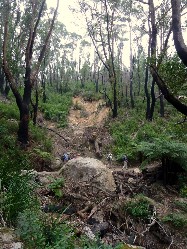 |
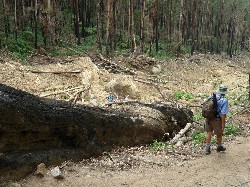 |
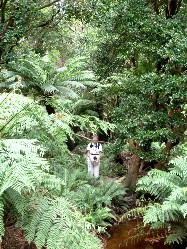 |
This track opened again
only 3 weeks ago
Click on thumbnail to enlarge photo |
Len and Lorelle inspect the landslip
Click on thumbnail to enlarge photo |
Susan on Lilly Pilly Circuit
Click on thumbnail to enlarge photo |
“I am NOT going up the mountain next Friday that’s for sure!!!”
“Hands up who wants to go to the top of the mountain?”
“Yes I will – its Bettys walk!!!” – am I crazy????
As we walked up the eerie track we felt like the girls from Picnic at
Hanging Rock disappearing into the fog and we hoped we would return!! What did
we see from the top after our leisurely (or “slow” according to Betty!!)
stroll? NOTHING - too foggy.
So off Betty flashed down the mountainside with the rest of us following at
our own pace. Then onto Lilly Pilly Circuit, across the boardwalk looking at
the beautiful ferns. We arrived back at the carpark and seeing as we had
enjoyed the walk and the company so much, we then walked to the Tidal River
camping area. What a great day – Thank you Betty.....Another nice report, whoever you are
back to Top
WAKEFUL IN WILSONS PROM - HELEN & MARTIN'S WOMBAT TALE
Monday.....We congratulated ourselves on the choice of campsite 340. It was
a quiet, beautiful spot surrounded by twisted tea trees. Just five minutes walk
to the sea at Norman Beach (and another five if the tide was out!), and full of
wildlife. Flocks of superb fairy wrens followed our every move, scrub wrens
investigated the undergrowth, and a pair of grey strike thrushes warbled their
way into our hearts. A frog chuckled at nightfall, deer darted about at night
and wombats munched grass on the verge. What an idyllic place to camp!
Tuesday.....After a day walking, we rested up in our tent with a mug of
Milo before Happy Hour. We were suddenly aware of a wombat walking the
perimeter of the tent and, having read the warning signs about keeping food out
of tents and in cars so wombats don’t cause problems, we immediately shooed it
away. The wind got up that evening; we cooked inside the tent and went to bed
unable to sleep from the noise of the wind and the irregular flapping of the tent.
We made frequent forays outside to check the tent pegs were secure. Around
10 pm we heard a new noise. Wombat had returned and was launching an attack on
the tent! I fumbled for the torch, flapped about trying to find the compartment
zipper; and finally arrived in the “living area” of the tent to see Wombat
attempting to push his way through the inner tent layer. I shoved him back and
as he moved to the side entrance I again confronted him with a lot of noise,
the torch in his eyes, whereupon he moved a few feet away. Then he stood there,
like a naughty child who’d been found out and was sulking. That wasn’t good
enough, I rushed at him noisily again. He decided that a half-dressed, middle-aged
Englishwoman defending her castle was too much to cope with and trundled off
down one of his tracks.
I was stunned - I had witnessed a wombat-style ram-raid! Martin was
impressed – he had witnessed Helen valiantly defending The Tent!
We retired to assess the damage, a small hole in the inner mesh and the
loosening of a tent peg. Martin mended the hole as any well-trained bushwalker
would, with duct tape!
Wednesday.....We told fellow bushwalkers our tale including the fact that
Wombat seemed clever and had “cased the joint” hours before his assault. Donna
and Kay remarked that, if he’d been that clever, he would have waited till we
left the tent for Happy Hour and made his assault then.
That afternoon, Martin set off for Happy Hour ahead of me so he could avail
himself of the camp facilities first. Moments later I came out of the tent to
meet Wombat! He turned and fled, maybe one confrontation with me was enough in 24 hours.
I had a dilemma, stay and defend The Tent, or go to Happy Hour. I packed up all
vestiges of cooking and food and locked them in the car. The Tent would have to
defend itself, I was off to Happy Hour!
Thursday.....After another windy and therefore noisy night, we had had no
further visitations. Wombat had been seen, a little way off, busily engaged
munching grass, or was he feigning disinterest? I had been responsible and
reported the case of “wombat aggression” to the Park Ranger at the office.
This involved a little paperwork to describe the incident and the Ranger had
muttered something about “if it happens again, you might need to move site”.
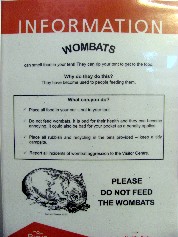 |
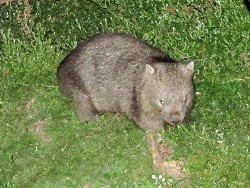 |
Beware of Wombats
Click on thumbnail to enlarge photo |
No tent is safe
Click on thumbnail to enlarge photo |
I felt uneasy about reporting Wombat. Who could blame him, these pesky humans
turned up uninvited in hoards every weekend and holiday period, making noise
and smells and parking tents and cars in the middle of wombat territory and
highways without any consideration. Why not have a bit of Wombat rage every
now and then to remind them who was here first? Then I worried, what if Wombat
is a serial offender and has to be dealt with? Have I dobbed him in for the final time?
Do they shoot rogue wombats for repeated aggression? Pull yourself together
Helen, this is a National Park, wombats are protected (except from cars on the roads).
After the afternoon Milo, we packed up ready for an early start back home
the following morning. The tent was, as ever, clear of food and any hint of
cooking utensils. We went blithely to a long Happy Hour. On our return to site 340,
Martin became concerned. There were wombat tracks in the dust right by the tent.
Of course there were, I said, Wombat was here yesterday, don’t panic. He
gingerly opened the tent. No Wombat, but 5 much bigger holes were now present
on the inner mesh! Wombat had returned! It took a lot more duct tape to fix
these holes.
We promised ourselves never to camp in Africa!
Wombat …….. 1 / Helen & Martin …….. 0 !
END
back to Top


























